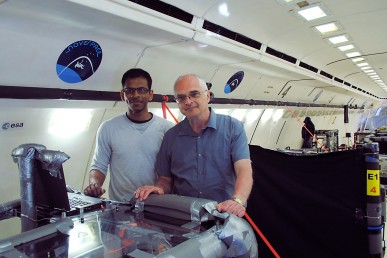UIC research flies high
Three years of preparation supported by NASA paid off this June for researchers from the University of Illinois at Chicago who conducted experiments while floating weightless on a Novespace & European Space Agency plane.
Under the direction of Alexander Yarin, UIC professor of mechanical and industrial engineering, two brothers—Suman Sinha Ray, a postdoctoral fellow and recent UIC graduate, and Sumit Sinha Ray, a graduate student—went aloft and braved high- and zero-gravity to test a cooling system Yarin’s team developed for hot-running microelectronics.
When liquid on a hot surface evaporates, it carries away heat. Yarin and his colleagues were interested in learning how well the evaporative cooling system they developed would work under conditions of twice-normal or zero gravity.
The UIC team, one of 12 international teams monitoring experiments onboard the Novespace Airbus plane, was collaborating with Professor C. Tropea from the Technische Universität Darmstadt, in Germany, who sent three students onboard.
The Novespace Airbus’ parabolic flights produced conditions of weightlessness and nearly double normal gravity. When the plane traces a parabola, gravitational force increases as it climbs or descends steeply. As the plane reaches its peak and floats over the top of the curve, the crew experiences weightlessness.
The flights were physically demanding but “exciting and fun,” said Suman. The crew was warned not to try to float around the cabin as astronauts do in the space station. When you move your head while weightless, he said, “your senses don’t match,” and many people become nauseated, even after a pre-flight anti-nausea injection.
Suman was right at home, Sumit said, and “worked on the computer very naturally as we ran the experiment.”
Sumit photographed the experiment while keeping a close eye on the pressurized rig running the system. Holding the camera steady as his feet floated off the floor was a challenge, he said, as was keeping an eye on his fellow travelers. He accidentally kicked a Japanese scientist who floated too close.

Postdoctoral researcher Suman Sinha Ray and Prof. Alexander Yarin in the Novespace Airbus (click on image for larger file size)
The UIC researchers were testing their cooling system for potential application in near or outer space.
Satellites, rockets and drones have elaborate electro-optical and infrared sensors, recording equipment and data processing systems. All of these electronics are designed with smaller and smaller elements that generate heat and can burn out.
“This is a problem that is very acute,” said Yarin. “We are very nearly at the limit of miniaturization because of the problem of heat removal.”
Yarin and his group have developed novel nano-textured surfaces that dramatically increase cooling efficiency. Their cooling system covers high-heat surfaces with mats made from tangles of nanofibers. The extremely thin fibers of the mat trap coolant against the surface so that evaporation is rapid and complete.
Over three days, the group flew three flights. On each 3 ½-hour flight, the plane flew 31 parabolas—five minutes through the curve, five minutes rest, then another five-minute parabola, with a rest after every third parabola. They will now analyze the data collected during the high-gravity and zero-gravity portions of the parabolic flights to understand how the cooling system works under the conditions of space applications.
Yarin’s group and the international collaboration with the Technische Universität Darmstadt was supported by NASA through grant NNX10AR99G.
